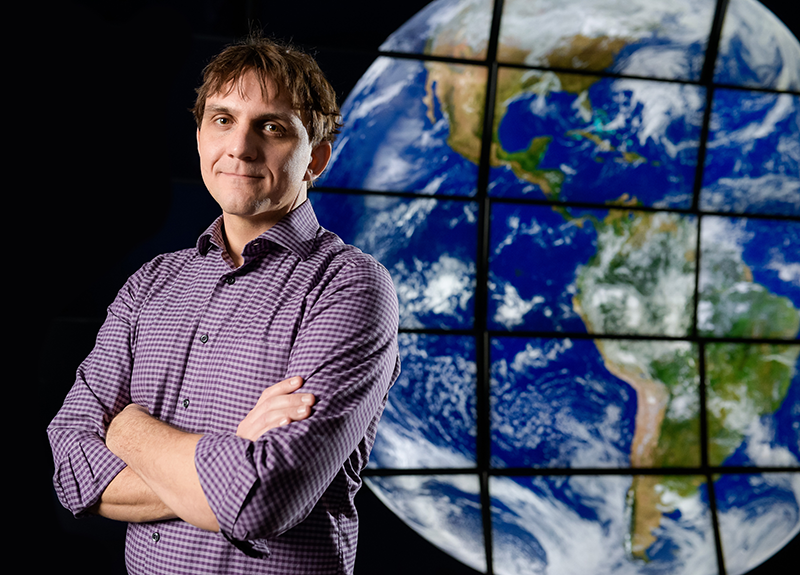Building a Better Fuel Cell
Fuel cells accomplish a very important task—they take chemical fuel and turn it into electricity. In that sense, fuel cells resemble fossil-fuel power plants, but with a distinct and very important advantage: they function much more efficiently and cleanly. In fact, fuel cells produce zero carbon emissions if fueled with hydrogen—a process that is increasingly easy to accomplish. Sossina M. Haile, Walter P. Murphy Professor of Materials Science and Engineering and professor of applied physics at Northwestern, focuses her work in the ISEN Flex Lab on creating the electrodes for fuel cells and other electrochemical devices. Her research is supported by an Advanced Research Projects Agency-Energy grant from the US Department of Energy, helping to clear a pathway for her breakthroughs to reach the marketplace. Read More
Reinventing the Wheel
Rubber can’t be recycled, only repurposed. Of the 244 million scrap tires that were disposed of in the United States in 2015, more than 50 percent were simply burned for fuel. More than 10 percent—20 million tires—were consigned to landfill. John Torkelson, Walter P. Murphy Professor of Chemical and Biological Engineering and Materials Science and Engineering at Northwestern, is striving to change all that. Torkelson and his research team have developed a one-step, inexpensive solution that modifies the way in which the polymers in rubber—that is, the chains of molecules that give structure and properties to larger molecules—are linked. Torkelson’s recyclable rubber has applications that range from common products like shoes and tires to advanced aerospace materials. Read More
New Battery Storage Material Shows Its Power
A powerful new nanomaterial developed by William Dichtel, Robert L. Letsinger Professor of Chemistry at Northwestern, and his research team could one day greatly speed up the charging process of electric vehicles and help increase their driving range. The material combines the best of batteries (the ability to store large amounts of electrical energy) and supercapacitors (the ability to charge and discharge rapidly). In his experiments, Dichtel has combined a covalent organic framework (COF)—a strong, stiff polymer with an abundance of tiny pores suitable for storing energy—with a very conductive material. This first-of-its-kind modified COF can store roughly 10 times more electrical energy than the unmodified COF, and it can get the electrical charge in and out of a device 10 to 15 times faster. As an added benefit, Dichtel’s COFs are made of inexpensive, readily available materials. Read More
Solar Power in Zero Gravity
Like other types of solar cells, dye-sensitized solar cells convert energy from the sun into an electric current. Though dye-sensitized cells are cheap and simple to manufacture, they are inefficient relative to monocrystalline solar cells, which make up the panels found on most house rooftops. The reason? The base of the dye-sensitized cell is constructed from a porous foam material that, due to manufacturing limitations, is comprised of randomized holes that restrict the orderly flow of electrons. The possible solution? Remove gravity from the manufacturing process. David Dunand, James N. and Margie M. Krebs Professor of Materials Science and Engineering at Northwestern, and a team of students are experimenting with freeze-casting materials in zero gravity. The NASA-supported process will allow the researchers to more easily manipulate the structure of the pores, thereby greatly improving the efficiency with which the dye-sensitized solar cells can transport the electrons they collect from sunlight. Read More
Energy-Neutral Chemical Manufacturing
Industrial chemical manufacturers use approximately 2.1 billion kilowatt-hours of electricity annually to produce about 30 million tons of formaldehyde worldwide. That’s enough energy to power 200,000 homes in the United States for a year, according to the US Energy Information Administration. At the ISEN Flex Lab, Tracy L. Lohr, research assistant professor of chemistry at Northwestern, is experimenting with a new method of commercial formaldehyde production—one that is completely energy neutral. Her prototype reactor, which leverages bio-available methanol in its production, is designed to yield high, single-pass conversion to formaldehyde while recycling co-produced hydrogen to fuel the process. Read More
Finding Ideal Materials for Carbon Capture
In recent years, a class of tiny, highly absorbent, porous crystalline structures called metal-organic frameworks (MOF) have emerged as a promising material for carbon capture and sequestration. Scientists can tweak and fine-tune countless variables in their MOF design. But there’s a downside—with so many interconnected variables, finding the optimal MOF for a pre-determined application such as carbon capture can be difficult. Randy Snurr, John G. Searle Professor of Chemical and Biological Engineering at Northwestern, has discovered a way to rapidly identify top MOF candidates for carbon capture by applying a genetic algorithm. One of the identified MOFs, a variant of NOTT-101, has a higher capacity for carbon capture than any MOF reported in scientific literature. Read More







